快慢指针
四个类似的问题:
1、 输入链表头部,奇数长度返回中点,偶数长度返回上中点;
2、 输入链表头部,奇数长度返回中点,偶数长度返回下中点;
3、 输入链表头部,奇数长度返回中点前一个,偶数长度返回上中点前一个;
4、 输入链表头部,奇数长度返回中点前一个,偶数长度返回下中点前一个;
处理逻辑都一样,都是设置一个快指针和一个慢指针,快指针每次遍历两个结点,慢指针每次遍历一个结点,当快指针无法往后遍历时,返回慢指针指向的节点。
唯一不同的就是慢指针和快指针的初始指向。
/**
* 快慢指针
*/
public class LinkedList01 {
/**
* 输入链表头部,奇数长度返回中点,偶数长度返回上中点
* @param head
* @return
*/
public static Node find01(Node head) {
if (head == null || head.next == null) {
return head;
}
Node slow = head;
Node fast = head;
while (fast.next != null && fast.next.next != null) {
slow = slow.next;
fast = fast.next.next;
}
return slow;
}
/**
* 输入链表头部,奇数长度返回中点,偶数长度返回下中点
* @param head
* @return
*/
public static Node find02(Node head) {
if (head == null || head.next == null) {
return head;
}
Node slow = head.next;
Node fast = head.next;
while (fast.next != null && fast.next.next != null) {
slow = slow.next;
fast = fast.next.next;
}
return slow;
}
/**
* 输入链表头部,奇数长度返回中点前一个,偶数长度返回上中点前一个
* @param head
* @return
*/
public static Node find03(Node head) {
if (head == null || head.next == null) {
return head;
}
Node slow = head;
Node fast = head.next.next;
while (fast.next != null && fast.next.next != null) {
slow = slow.next;
fast = fast.next.next;
}
return slow;
}
/**
* 输入链表头部,奇数长度返回中点前一个,偶数长度返回下中点前一个
* @param head
* @return
*/
public static Node find04(Node head) {
if (head == null || head.next == null) {
return head;
}
Node slow = head;
Node fast = head.next;
while (fast.next != null && fast.next.next != null) {
slow = slow.next;
fast = fast.next.next;
}
return slow;
}
private static class Node {
private Node next;
private int value;
}
}
输入一个链表头结点,判断链表是否是回文结构
三种方法:
1、 把链表结点压入栈中,此时栈中结点的顺序与链表相反,一个个弹出与链表结点比较即可;
2、 通过快慢指针,然慢指针指向链表中间节点,然后只把后半部分节点压入栈中,与列表节点进行比较,节省一半空间;
3、 通过快慢指针,然慢指针指向链表中间节点,然后把后把部分的节点的next指针反转,再用两个指针,一头一尾,遍历进行比较,比较完毕后还原后半部分节点的next指针;
第三种方法:
1、 先通过快慢(块指针每次走两步,慢指针每次走一步)指针,找到中点;

2、 把慢指针后面的点的指针逆序;

3、 左右指针遍历,左右点比对,指针某个指针遍历到null为止;

4、 遍历完毕后,还原链表;

/**
* 输入一个链表头结点,判断链表是否是回文结构
*/
public class LinkedList02 {
public static boolean isReverse01(Node head) {
if (head == null && head.next == null) return true;
Stack<Node> stack = new Stack<>();
Node help = head;
//把链表中的所有结点压入栈中
while (help != null) stack.push(help);
boolean res = true;
help = head;
//此时从栈顶到栈底,结点顺序与链表相反,从链表头部开始遍历,每遍历一个节点,从栈中弹出一个进行比较
while (!stack.isEmpty()) {
res &= stack.pop().value == help.value;
help = help.next;
}
return res;
}
public static boolean isReverse02(Node head) {
if (head == null && head.next == null) return true;
//使用快慢指针,取到链表中点,只把链表后半部分压入栈中,与前半部分比较
Node slow = head;
Node fast = head;
while (fast.next != null && fast.next.next != null) {
slow = slow.next;
fast = fast.next.next;
}
//把链表后半部分压入栈中
Stack<Node> stack = new Stack<>();
Node n2 = slow.next;
boolean res = true;
while (n2 != null) {
stack.push(n2);
n2 = n2.next;
}
//与前半部分比较
n2 = head;
while (!stack.isEmpty()) {
res &= stack.pop().value == n2.value;
n2 = n2.next;
}
return res;
}
public static boolean isReverse03(Node head) {
if (head == null && head.next == null) return true;
//使用快慢指针,取到链表中点,把链表后半部分指针反转,然后与前半部分进行比较,笔记完毕后把指针还原
Node slow = head;
Node fast = head;
while (fast.next != null && fast.next.next != null) {
slow = slow.next;
fast = fast.next.next;
}
//把链表后半部分指针反转
Node n1 = slow;
Node n2 = n1.next;
n1.next = null;
Node n3 = null;
while (n2 != null) {
n3 = n2.next;
n2.next = n1;
n1 = n2;
n2 = n3;
}
//前后两半部分进行比较
n3 = n1;
n2 = head;
boolean res = true;
while (n1 != null && n2 != null) {
res &= n1.value == n2.value;
n1 = n1.next;
n2 = n2.next;
}
//链表还原
n1 = n3.next;
n3.next = null;
while (n1 != null) {
n2 = n1.next;
n1.next = n3;
n3 = n1;
n1 = n2;
}
return res;
}
private static class Node {
private Node next;
private int value;
}
}
将单向链表按某值划分为左边小,中间等于,右边大于的形式
两种方法:
1、 把链表的每个节点放到数组里,做一次partition(笔试用);
2、 弄6个指针代表3个链表,分别是小于区域头指针、大于区域尾指针、等于区域头指针、等与区域尾指针、大于区域头指针、大于区域尾指针,遍历原链表,生成3个新链表,最后把这3个链表连起来,就是新的符合要求的链表(面试用);
第二种方法:
1、 遍历链表,往3个区域发货;

2、 遍历完后就是3个新链表;
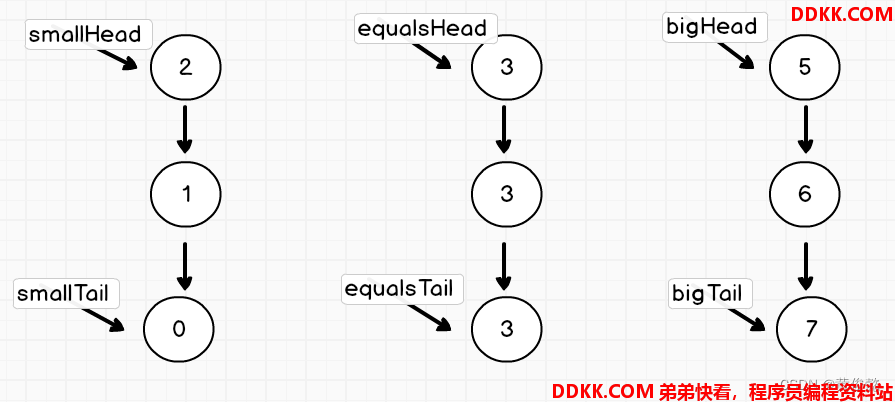
3、 链好3个新链表,返回新的头结点;
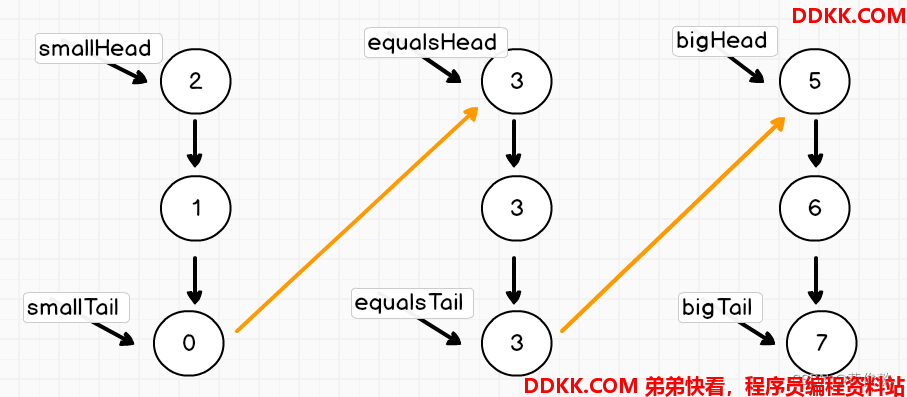
/**
* 将单向链表按某值划分为左边小,中间等于,右边大于的形式
*/
public class LinkedList03 {
public static Node partition01(Node head, int pivot) {
if (head == null || head.next == null) return head;
//计算链表大小,并创建对应大小的数组,临时存放链表结点
Node help = head;
int size = 0;
while (help != null) {
size++;
head = help.next;
}
Node[] arr = new Node[size];
help = help;
int index = 0;
while (help != null) {
arr[index++] = help;
help = help.next;
}
//根据pivot基准值,对数组做partition操作
int i1 = -1; //(...i1] 小于区
int i2 = 0; // (i1...i2] 等于区
int i3 = arr.length; // (i2...i3]大于区
while (i2 != i3) {
Node curr = arr[i2];
if (curr.value < pivot) {
swap(arr, ++i1, i2++);
} else if (curr.value > pivot) {
swap(arr, i2, --i3);
} else {
i2++;
}
}
//遍历数组,把结点串起来
Node prev = arr[0];
for (int i = 1; i < arr.length; i++) {
prev.next = arr[i];
prev = arr[i];
}
return arr[0];
}
public static Node partition02(Node head, int pivot) {
if (head == null || head.next == null) return head;
Node smallHead = null; //小于区头结点
Node smallTail = null; //小于区尾结点
Node equalsHead = null; //等于区头结点
Node equalsTail = null; //等于区尾结点
Node bigHead = null; //大于区头结点
Node bigTail = null; //大于区尾结点
//遍历链表,组装小于区、等于区、大于区的链表,并且每遍历一个结点,就把原来的next指针断掉
Node next;
while (head != null) {
next = head.next;
head.next = null;
if (head.value < pivot) {
if (smallHead == null) {
smallHead = head;
smallTail = head;
} else {
smallTail.next = head;
smallTail = head;
}
} else if (head.value == pivot) {
if (equalsHead == null) {
equalsHead = head;
equalsTail = head;
} else {
equalsTail.next = head;
equalsTail = head;
}
} else {
if (bigHead == null) {
bigHead = head;
bigTail = head;
} else {
bigTail.next = head;
bigTail = head;
}
}
head = next;
}
//小于区的尾部连接等于区的头部,等于区的头部连接大于区的头部,但是要判断边界情况,就是小于区、等于区有可能为空
if (smallHead != null) {
smallTail.next = equalsHead;
equalsTail = equalsHead == null ? smallTail : equalsTail;
}
if (equalsHead != null) {
equalsTail = bigHead;
}
return smallHead != null ? smallHead : (equalsHead != null ? equalsHead : bigHead);
}
private static class Node {
private int value;
private Node next;
}
private static void swap(Node[] arr, int i, int j) {
Node temp = arr[i];
arr[i] = arr[j];
arr[j] = temp;
}
}
链表结点带rand指针克隆问题
两种方法:
1、 遍历原链表,生成一个map,key是原链表节点,value是新的克隆结点,然后遍历map,处理每个克隆节点的next指针,和rand指针,两指针要连的节点,都可以通过原链表节点在map中找到(笔试用);
2、 遍历链表,生成克隆结点,生成克隆结点后,原链表节点的next指针指向克隆结点,然后克隆结点的next指针指向原链表节点的下一个节点,也就是克隆结点嵌在原链表中间;然后成对遍历链表,处理克隆结点的rand指针;然后在遍历一次链表,分离两个链表;
第二种方法:
1、 假设这是原链表;

2、 生成克隆结点,嵌在原链表中间;

3、 成对遍历链表,处理克隆结点的rand指针;

4、 分离出克隆结点链表;

/**
* 链表结点带rand指针克隆问题
*/
public class LinkedList04 {
public static Node clone01(Node head) {
if (head == null) return null;
//原结点 -> 克隆结点
Map<Node, Node> map = new HashMap<>();
//建立原结点与克隆结点的映射关系
Node help = head;
while (help != null) {
Node copy = new Node();
copy.value = help.value;
map.put(help, copy);
help = help.next;
}
//根据map中记录的原结点与克隆结点的映射关系,给克隆结点的next指针与rand指针赋值
help = head;
while (help != null) {
Node copy = map.get(help);
if (help.next != null) copy.next = map.get(help.next);
if (help.rand != null) copy.rand = map.get(help.rand);
help = help.next;
}
return map.get(head);
}
public static Node clone02(Node head) {
//1、遍历列表,克隆结点,并把克隆结点连接到原结点后面
//1->`1->`2->`2->`3->`3
Node help = head;
while (help != null) {
Node next = help.next;
Node copy = new Node();
copy.value = help.value;
help.next = copy;
copy.next = next;
help = next;
}
//2、遍历链表,处理克隆结点的rand指针
help = head;
while (help != null) {
Node next = help.next.next;
Node copy = help.next;
if (help.rand != null) copy.rand = help.rand.next;
help = next;
}
//3、链表分离
Node res = help.next;
help = head;
while (help != null) {
Node next = help.next.next;
Node copy = help.next;
help.next = next;
if (next != null) copy.next = next.next;
help = next;
}
return res;
}
private static class Node{
private int value;
private Node next;
private Node rand;
}
}
给定一个链表,如果有环则返回环中的第一个节点,没有则返回null
定一个快指针和一个慢指针,快指针一次走两步,慢指针一次走一步,两指针在环中相遇后,快指针回到头节点,两指针都每次走一步,它们必在入环节点相遇
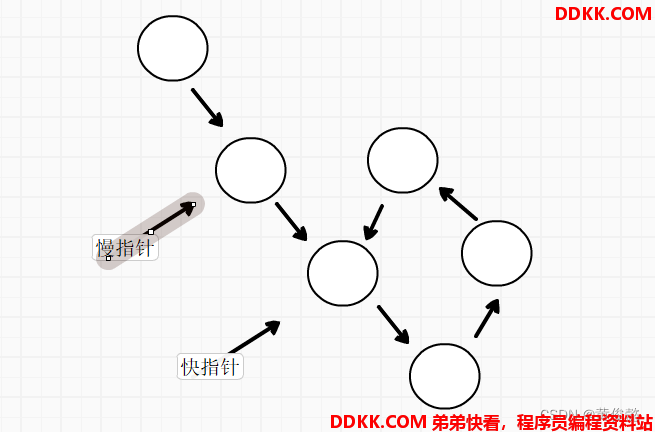
/**
* 给定一个链表,如果有环则返回环中的第一个节点,没有则返回null
*/
public class LinkedList05 {
public static Node find(Node head) {
if (head == null || head.next == null || head.next.next == null) return null;
//快慢指针,如果有环,两指针会在环中相遇
Node slow = head.next;
Node fast = head.next.next;
while (slow != fast) {
if (fast == null || fast.next == null) return null;
slow = slow.next;
fast = fast.next.next;
}
//让fast指针回到头结点,每一次走一步,快慢指针相遇的结点,就是环中第一个节点
fast = head;
while (fast != null) {
slow = slow.next;
fast = fast.next;
}
return fast;
}
private static class Node {
private int value;
private Node next;
}
}
给定两个无环链表,返回两个链表相交的第一个节点,没有则返回null
1、 先遍历两个链表,并记录长度;
2、 看两链表尾节点是否相等,是则代表有相交节点,否则两链表不相交;
3、 如果相交,长链表指针先走差值步,然后链表指针每次走一步,最后必在相交节点相遇;
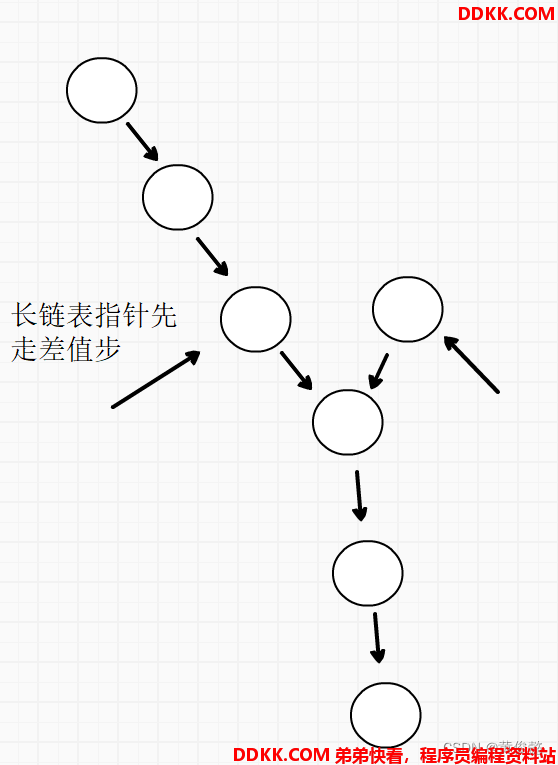
/**
* 给定两个无环链表,返回两个链表相交的第一个节点,没有则返回null
*/
public class LinkedList06 {
public static Node findIntersectNode(Node head1, Node head2) {
if (head1 == null || head2 == null) return null;
//先遍历head1,计算head1长度
int len = 0;
Node curr1 = head1;
while (curr1.next != null) {
len++;
curr1 = curr1.next;
}
//遍历head2,每遍历一个结点,len减一,计算出两个链表长度的差值
Node curr2 = head2;
while (curr2.next != null) {
len--;
curr2 = curr2.next;
}
//此时curr1和curr2都指向各自链表的尾结点,如果不是同一个尾结点,代表两链表没有相交,返回null
if (curr1 != curr2) return null;
//调整curr1和curr2指针,让cuur1指针指向长度较长的链表头结点
curr1 = len < 0 ? head2 : head1;
curr2 = curr1 == head1 ? head2 : head1;
//此时len为两链表长度的差值,保证len为正数
len = Math.abs(len);
//curr1先走len步,使得curr1和curr2指向的结点开始到尾节点长度一样
while (len != 0) {
len--;
curr1 = curr1.next;
}
//curr1和curr2每次各自走一步,最后必会到达相交处
while (curr1 != curr2) {
curr1 = curr1.next;
curr2 = curr2.next;
}
return curr1;
}
private static class Node {
private int value;
private Node next;
}
}
两个有环链表,给定链表头结点和环中第一个节点,找出两个链表相交的结点,没有相交则返回null
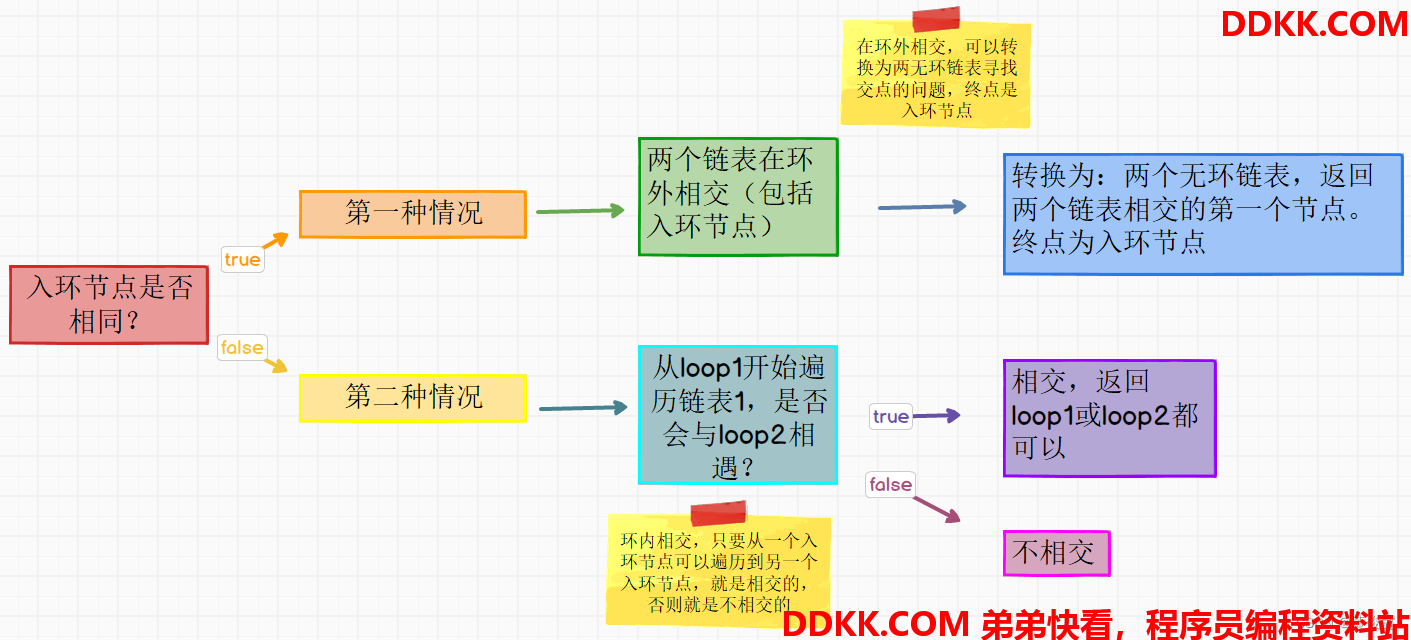
/**
* 两个有环链表,给定链表头结点和环中第一个节点,找出两个链表相交的结点,没有相交则返回null
*/
public class LinkedList07 {
public static Node findLoopIntersect(Node head1, Node loop1, Node head2, Node loop2) {
Node curr1 = null;
Node curr2 = null;
// 第一种情况:两个链表在环外相交
if (loop1 == loop2) {
curr1 = head1;
curr2 = head2;
//遍历链表1,计算到入环结点的长度
int len = 0;
while (curr1 != loop1) {
len++;
curr1 = curr1.next;
}
//遍历链表二,也是到入环结点就停止,计算两个链表长度的差值
while (curr2 != loop2) {
len--;
curr2 = curr2.next;
}
//调整curr1指向长度较长链表的头结点
curr1 = len < 0 ? head2 : head1;
curr2 = curr1 == head1 ? head2 : head1;
//保证len为正数
len = Math.abs(len);
//curr1走len步,此时cuur1到入环结点与curr2到入环结点的长度相同
while (len > 0) {
len--;
curr1 = curr1.next;
}
//curr1和curr2每次走1步,到入环结点或入环结点前必会相遇
while (curr1 != curr2) {
curr1 = curr1.next;
curr2 = curr2.next;
}
return curr1;
} else {
//第二种情况,两个链表的入环结点不相同
curr1 = loop1.next;
//从loop1开始遍历链表1,看是否会与loop2相遇,是则两链表相交,返回loop1或loop2都可以,不会相遇则会回到loop1,返回null
while (curr1 != loop1) {
if (curr1 == loop2) return loop1;
curr1 = curr1.next;
}
return null;
}
}
private static class Node {
private int value;
private Node next;
}
}
给定两个链表,有可能有环,也有可能无环,返回两个链表的相交结点,没有相交则返回null
可能的情况:
1、 两个链表都无环,退化为寻找两个无环链表相交结点的问题;
2、 一个链表有环,一个链表无环,不可能相交;
3、 两个链表都有环,分三种情况:;
3、 1、两个有环链表,不相交;
3、 2、两个有环链表,在环外相交(包括入环节点);
3、 3、两个有环链表,在环内相交(相交但是入环节点不同);
解法:
1、 先分别通过链表寻找入环节点的方法,找到两个链表的入环节点;
2、 如果两个入环节点都是null,则符号情况1,用寻找两个无环链表相交结点的方法求解;
3、 如果一个入环节点为null,另一个不为null,则符号情况2,返回null;
4、 如果两个入环节点都不为null,如果两个入环节点相等,则是情况3.2,以入环节点为终点,利用两无环链表寻找相交点的方式求交点;
5、 如果两个入环节点都不为null,以其中一个入环节点为起点,另一个入环节点为终点,从起点出发转一圈,看是否能到达终点,如果回到起点都没遇到终点,则是情况3.1,返回null;如果遇到终点,返回两个入环节点的其中一个就行;
/**
* 给定两个链表,有可能有环,也有可能无环,返回两个链表的相交结点,没有相交则返回null
*/
public class LinkedList08 {
public static Node find(Node head1, Node head2) {
if (head1 == null || head2 == null) return null;
//1、找出两个链表的入环结点
Node loop1 = findLoopNode(head1);
Node loop2 = findLoopNode(head2);
//如果loop1和loop2都为null,则退化为寻找两个无环链表相交结点的问题
if (loop1 == null && loop2 == null) {
return findIntersectNodeNoLoop(head1, head2);
}
//如果loop1和loop2都不为空,则简化为寻找两个有环链表的相交结点问题
if (loop1 != null && loop2 != null) {
return findLoopIntersect(head1, loop1, head2, loop2);
}
//如果一个链表有环,一个链表无环,不可能相交,返回null
return null;
}
/**
* 找出两个有环链表的相交结点,没有则返回null
* @param head1
* @param loop1
* @param head2
* @param loop2
* @return
*/
public static Node findLoopIntersect(Node head1, Node loop1, Node head2, Node loop2) {
Node curr1 = null;
Node curr2 = null;
// 第一种情况:两个链表在环外相交
if (loop1 == loop2) {
curr1 = head1;
curr2 = head2;
//遍历链表1,计算到入环结点的长度
int len = 0;
while (curr1 != loop1) {
len++;
curr1 = curr1.next;
}
//遍历链表二,也是到入环结点就停止,计算两个链表长度的差值
while (curr2 != loop2) {
len--;
curr2 = curr2.next;
}
//调整curr1指向长度较长链表的头结点
curr1 = len < 0 ? head2 : head1;
curr2 = curr1 == head1 ? head2 : head1;
//保证len为正数
len = Math.abs(len);
//curr1走len步,此时cuur1到入环结点与curr2到入环结点的长度相同
while (len > 0) {
len--;
curr1 = curr1.next;
}
//curr1和curr2每次走1步,到入环结点或入环结点前必会相遇
while (curr1 != curr2) {
curr1 = curr1.next;
curr2 = curr2.next;
}
return curr1;
} else {
//第二种情况,两个链表的入环结点不相同
curr1 = loop1.next;
//从loop1开始遍历链表1,看是否会与loop2相遇,是则两链表相交,返回loop1或loop2都可以,不会相遇则会回到loop1,返回null
while (curr1 != loop1) {
if (curr1 == loop2) return loop1;
curr1 = curr1.next;
}
//第三种情况,两链表不相交
return null;
}
}
/**
* 找出两个无环链表的相交几点,没有则返回null
* @param head1
* @param head2
* @return
*/
public static Node findIntersectNodeNoLoop(Node head1, Node head2) {
if (head1 == null || head2 == null) return null;
//先遍历head1,计算head1长度
int len = 0;
Node curr1 = head1;
while (curr1.next != null) {
len++;
curr1 = curr1.next;
}
//遍历head2,每遍历一个结点,len减一,计算出两个链表长度的差值
Node curr2 = head2;
while (curr2.next != null) {
len--;
curr2 = curr2.next;
}
//此时curr1和curr2都指向各自链表的尾结点,如果不是同一个尾结点,代表两链表没有相交,返回null
if (curr1 != curr2) return null;
//调整curr1和curr2指针,让cuur1指针指向长度较长的链表头结点
curr1 = len < 0 ? head2 : head1;
curr2 = curr1 == head1 ? head2 : head1;
//此时len为两链表长度的差值,保证len为正数
len = Math.abs(len);
//curr1先走len步,使得curr1和curr2指向的结点开始到尾节点长度一样
while (len != 0) {
len--;
curr1 = curr1.next;
}
//curr1和curr2每次各自走一步,最后必会到达相交处
while (curr1 != curr2) {
curr1 = curr1.next;
curr2 = curr2.next;
}
return curr1;
}
/**
* 找出链表入环结点,无环则返回null
* @param head
* @return
*/
public static Node findLoopNode(Node head) {
if (head == null || head.next == null || head.next.next == null) return null;
//快慢指针,如果有环,两指针会在环中相遇
Node slow = head.next;
Node fast = head.next.next;
while (slow != fast) {
if (fast == null || fast.next == null) return null;
slow = slow.next;
fast = fast.next.next;
}
//让fast指针回到头结点,每一次走一步,快慢指针相遇的结点,就是环中第一个节点
fast = head;
while (fast != null) {
slow = slow.next;
fast = fast.next;
}
return fast;
}
private static class Node {
private int value;
private Node next;
}
}
补充-LUR算法
简单版-直接使用系统提供的api
class LRUCache extends LinkedHashMap {
private int capacity;
public LRUCache(int capacity) {
super(capacity, 0.75F, true);
this.capacity = capacity;
}
public int get(int key) {
return (int)super.getOrDefault(key, -1);
}
public void put(int key, int value) {
super.put(key, value);
}
protected boolean removeEldestEntry(Map.Entry eldest) {
return size() > capacity;
}
}
纯手写版:
/**
* LRU内存替换算法
* Created by huangjunyi on 2022/10/1.
*/
public class _01LRU {
private static class Node<K, V> {
private Node last;
private Node next;
private K key;
private V value;
public Node(K key, V value) {
this.key = key;
this.value = value;
}
}
private static class DoubleLinkedList<K, V> {
private Node<K, V> head;
private Node<K, V> tail;
public DoubleLinkedList() {
this.head = null;
this.tail = null;
}
public void add (Node<K, V> node) {
if (node == null) return;
if (head == null) head = tail = node;
else {
node.last = tail;
tail.next = node;
tail = node;
}
}
public void moveToTail(Node<K, V> node) {
if (node == tail) return;
else if (node == head) {
head = node.next;
head.last = null;
} else {
node.last.next = node.next;
node.next.last = node.last;
}
node.last = tail;
node.next = null;
tail.next = node;
tail = node;
}
public Node<K, V> removeCurrHead() {
if (head == null) return null;
Node res = head;
if (head == tail) {
head = null;
tail = null;
} else {
head = res.next;
res.next = null;
head.last = null;
}
return res;
}
}
private static class LRUCache<K, V> {
private HashMap<K, Node<K, V>> keyNodeMap;
private DoubleLinkedList<K, V> list;
private int capacity;
public LRUCache(int capacity) {
keyNodeMap = new HashMap<>();
list = new DoubleLinkedList<>();
this.capacity = capacity;
}
public void put(K key, V value) {
if (keyNodeMap.containsKey(key)) {
Node<K, V> node = keyNodeMap.get(key);
node.value = value;
list.moveToTail(node);
} else {
if (keyNodeMap.size() == capacity) {
Node<K, V> node = list.removeCurrHead();
if (node != null) keyNodeMap.remove(node.key);
Node<K, V> newNode = new Node<>(key, value);
keyNodeMap.put(key, newNode);
list.add(newNode);
}
}
}
}
}